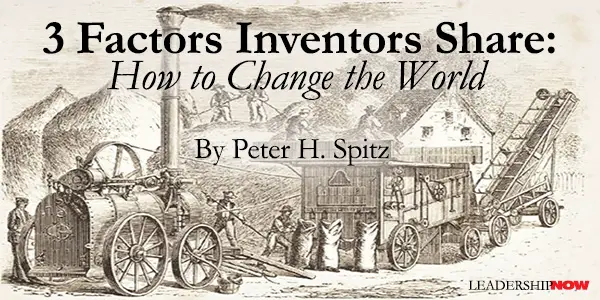 |
 |
08.19.24

3 Factors Inventors Share: How to Change the World
WHAT does it take to make an impact on the world? A great idea, yes, but also three common traits: opportunity, perseverance, and faith. As an inventor with seven patents in the energy and chemical areas I can cite my own experience to substantiate the importance of these traits as factors that lead to success. When I looked back into history to track the origins of some of the everyday innovations we take for granted today, I found that every inventor tended to embody some or all of these same traits. As far back as the Industrial Revolution, inventors have had to focus on more than that brilliant concept — they had to focus on seizing and seeing opportunities, persevering despite the odds, and having faith in their vision and themselves. Consider these four examples: The computer: A thru-line of seeing an opportunity for improvement. In the early 1880s, Charles Babbage, a British mathematician, constructed machines for computing mathematical tables and for conducting calculations using punched cards and a steam engine. Ada Lovelace and two other technicians subsequently wrote programs and built a printing calculator and a punch card tabulating machine. It took a financial entrepreneur, Charles Flint, to merge several of these companies, creating International Business Machines (IBM) in 1924. The radio: A young Italian student perseveres. Guglielmo Marconi was convinced there was a way to send signals through the atmosphere without wires despite being met with rampant skepticism. The technically gifted student conducted several years of promising experiments in Bologna. Finding no local support, he moved his experiments to England and gained the support of Sir. William Pierce, a high-level executive of the British Post Office. The British Marconi Company was founded in 1897. Marconi companies in other countries would dominate wireless transmissions for twenty years. The microwave oven: A company employee keeps the faith. A Raytheon employee named Percy Spencer was shooting down German planes during World War II when his radar gun accidentally melted a candy bar in his pocket. Realizing the device could be used for high-level heating, he and a Raytheon executive cooperated to develop the microwave oven. It took a lot of determination and detours to introduce this blockbuster kitchen appliance in the early 1960s — and it's become a kitchen staple. Post-its: Opportunity plus perseverance equals something we can't do without. Two 3M employees, Spencer Silver and Arthur Fry, discovered that a potential adhesive sticker applied to paper could easily be pulled off. While most 3M researchers had no interest in the development, the inventors stayed the course and had the faith their discovery would be recognized in time. The innovation-friendly culture of the company helped — and eventually, the discovery led to the immensely successful Post-it, first introduced in 1978. The moral of the story: discovery is thrilling, but a good idea is just the beginning. Persisting and tending that discovery by creating a foundation of support is even better. Historically, successful inventions have always been about personal initiative combined with support — a backer, a mentor, a sponsor. Further, the approach taken early in a career can help or hinder in the future, and that goes for any field. So pay special attention to these elements in any project and endeavor you're involved with:
Particularly when you're working in the fields of business, economic development, and innovation, and if you're an aspiring innovator, inventor, entrepreneur, or motivated employee, these three factors will create a solid foundation for later success. But while it's sometimes assumed that the act and business of invention were easier during the Industrial Revolution, think again. In so many cases, new technology exceeded most peoples' imaginations, and inventors had to break new ground in more ways than one. In today's climate, truly anything is possible, and we need all the solutions we can create. It's a good time to innovate.  
Posted by Michael McKinney at 08:59 AM
|
BUILD YOUR KNOWLEDGE
 

How to Do Your Start-Up Right STRAIGHT TALK FOR START-UPS 
Grow Your Leadership Skills NEW AND UPCOMING LEADERSHIP BOOKS 
Leadership Minute BITE-SIZE CONCEPTS YOU CAN CHEW ON 
Classic Leadership Books BOOKS TO READ BEFORE YOU LEAD |